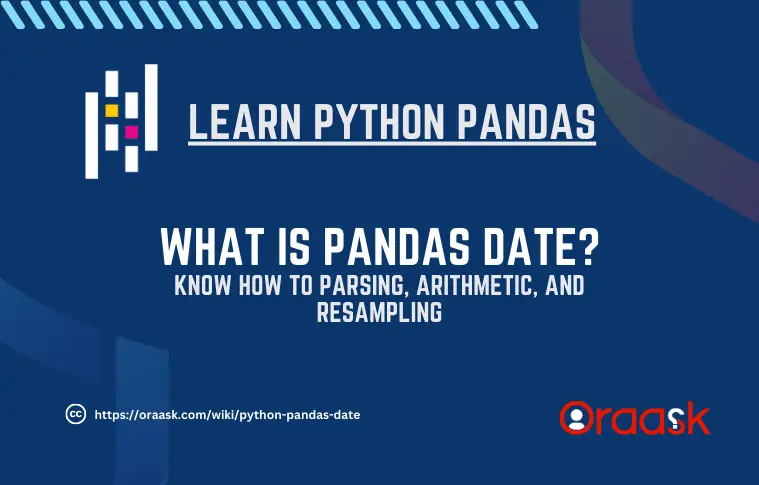How Can We Help?
Pandas is one of the most popular libraries of Python. This data visualization library deals with the operations related to data. In data analysis, we often must deal with the date and time functionality, e.g., forecasting data. These functionalities make it easier to work with dates in a data analysis setting and perform operations such as date arithmetic and resampling. In this article, we shall discuss the data functionality available in Python.
Before diving into parsing dates, it’s essential to understand the diverse ways dates are represented in Python. The primary methods include:
1. String Representations: Dates can be expressed as strings (e.g., “YYYY-MM-DD“) for readability but lack direct manipulation capabilities.
2. Datetime Objects: The datetime module creates objects that combine both date and time information, enabling calculations and comparisons.
3. Timestamps: Timestamps, numeric representations of time since the epoch, are efficient for precise time-based operations.
Mastering these representations sets the stage for effectively working with dates in Python.
Pandas Date Parsing
One of the most basic tasks in data analysis is parsing dates from various formats. Pandas make parsing dates from various formats accessible using the to_datetime function. The to_datetime function can convert various date formats, including ISO 8601, UNIX timestamp, and many others, to Pandas datetime objects.
Example (1)
# Import the pandas library
import pandas as pd
# Set a date in the form of a string
date_str = '2023-03-05'
# Use the to_datetime function to convert to the proper date-time format
date_obj = pd.to_datetime(date_str)
print(date_obj)Output:
2023-03-05 00:00:00
Explanation:
The above code first defined a dummy date as a string. Next, we used the to_datetime function of pandas to convert this string into a proper date-time format. The format can then be used for performing date-time operations. Note here that 00:00:00 suggests 00 hours, 00 minutes, and 00 seconds.
We can also use the same method for time and timezone values and convert them into the required date-time format.
Example (2)
# Import the pandas library
import pandas as pd
# Set a date in the form of a string
date_str = '2023-03-05 10:30:00+05:30'
# Use the to_datetime function to convert to the proper date-time format
date_obj = pd.to_datetime(date_str)
print(date_obj)Output:
2023-03-05 10:30:00+05:30
Explanation:
In the code above, we parse a date string with time and timezone information and convert it to a Pandas datetime object.
Create Periods and Frequency in Pandas
A critical feature of pandas date-time functionality is implementing the periods and frequency. Pandas allow doing so using the date_range function.
Example (3)
import pandas as pd
date=pd.date_range('3/3/2023',periods=10,freq='M')
print(date)Output:
DatetimeIndex([‘2023-03-31’, ‘2023-04-30’, ‘2023-05-31’, ‘2023-06-30’, ‘2023-07-31’, ‘2023-08-31’, ‘2023-09-30’, ‘2023-10-31’, ‘2023-11-30’, ‘2023-12-31′], dtype=’datetime64[ns]’, freq=’M’)
We have 10 entries in the output because we have mentioned periods=10, and we have got the month index incremented by one in each adjacent element because we have set the freq attribute to be ‘M’, which signifies the frequency by month.
Using the dot notation, we can get the year, month, day, etc of the time in padas. Pandas store the data as objects by default; hence, we can access them with the dot notation.
Example (4)
import pandas as pd
time=pd.datetime.now()
print(time.year)
print(time.month)
print(time.day)
print(time.hour)
print(time.minute)
print(time.second)
print(time.microsecond)
print(time.microsecond)Output:
2023
3
5
21
57
54
628578
628578
Correctly parsing dates before engaging in arithmetic operations. This step is pivotal in ensuring accuracy and reliability when working with dates in Python using the Pandas library.
Pandas offers a comprehensive suite of date and time functionalities that can greatly simplify date manipulations. However, these operations heavily rely on the accurate parsing of dates. Incorrectly parsed dates can lead to flawed calculations and unexpected results.
When utilizing Pandas for date arithmetic, start by ensuring your date data is accurately and consistently parsed. This groundwork forms the foundation for seamless and dependable date calculations, empowering you to derive meaningful insights from your data.
Pandas Date Arithmetic
We can perform various arithmetic operations once we have parsed dates into a Pandas datetime object. For example, we can add or subtract days, weeks, months, or years from a given date. This section discusses the arithmetic operations which we can perform with the datetime data generated by pandas.
Example (5)
# Import the pandas library
import pandas as pd
# Set a dummy date
date_obj = pd.to_datetime('2023-03-05')
# Add 1 day to the date
new_date_obj = date_obj + pd.Timedelta(days=1)
print(new_date_obj)
# Subtract 1 week from the date
new_date_obj = date_obj - pd.Timedelta(weeks=1)
print(new_date_obj)
# Add 1 month to the date
new_date_obj = date_obj + pd.offsets.MonthEnd(1)
print(new_date_obj)Output:
2023-03-06 00:00:00
2023-02-26 00:00:00
2023-03-31 00:00:00
Explanation:
- In this code snippet, we used the date and time functionalities of the Pandas library to perform arithmetic operations on a date object. We start by importing the Pandas library using the import pandas as a pd statement. We then set a dummy date using the
pd.to_datetimefunction, which parses a date string and returns a Pandas datetime object. - We then performed three arithmetic operations on the date object. First, we added one day to the date using the
pd.Timedeltafunction, which creates a time delta of one day and adds it to the date object. The resulting object is stored in the new_date_obj variable and printed using the print statement. - Next, we subtracted one week from the date object using the
pd.Timedeltafunction with a value of -1 week. This creates a time delta of one week in the past and subtracts it from the date object. The resulting object is stored in thenew_date_objvariable and printed using the print statement. - Finally, we added one month to the date object using the
pd.offsets.MonthEndfunction. This function adds the number of days required to reach the end of the following month to the date object. The resulting object is stored in thenew_date_objvariable and printed using the print statement. - By performing these arithmetic operations, we can manipulate dates easily using the date and time functionalities provided by Pandas. These operations can be helpful in various data analysis scenarios, such as calculating time deltas, creating time-based intervals, and generating time-series data.
Date arithmetic enables you to create custom date intervals by adding or subtracting time spans from existing dates. This ability is particularly valuable when you want to resample data at different frequencies or time intervals. By strategically applying date arithmetic, you can generate diverse date ranges that align with your data analysis goals.
For instance, you might have daily data and wish to resample it into weekly or monthly intervals. With date arithmetic, you can construct new date ranges that encapsulate these intervals, allowing you to perform resampling operations effectively using Pandas’ resampling functions.
In essence, mastering date arithmetic empowers you to shape time periods to suit your analysis needs, enhancing the precision and depth of your data insights through resampling techniques in Python Pandas.
Resampling using Date Time of Pandas
To demonstrate how to resample time-series data using Pandas with a dataset available on Kaggle, we will use the “Bike Sharing Demand” dataset. This dataset contains hourly counts of bike rentals in Washington, D.C., over a period of two years.
First, you need to download the data set from Kaggle. We are using the Bike Sharing Dataset available in Kaggle. You can download it from the following link:
https://www.kaggle.com/datasets/lakshmi25npathi/bike-sharing-dataset
Example (6)
import pandas as pd
# Load the dataset
df = pd.read_csv('train.csv')
# Convert the 'dteday' column to datetime format
df['datetime'] = pd.to_datetime(df['datetime'])
# Set the 'dteday' column as the index
df.set_index('datetime', inplace=True)
# Resample the data to daily frequency and calculate the total count of bike rentals for each day
daily_rentals = df['temp'].resample('D').sum()
# Resample the data to weekly frequency and calculate the average count of bike rentals for each week
weekly_rentals = df['temp'].resample('W').mean()
# Resample the data to monthly frequency and calculate the median count of bike rentals for each month
monthly_rentals = df['temp'].resample('M').median()
print(f"The daily rental is as follows:{daily_rentals}")
print(weekly_rentals)
print(monthly_rentals)Output:
The daily rental is as follows:datetime
2011-01-01 338.66
2011-01-02 342.76
2011-01-03 177.12
2011-01-04 188.60
2011-01-05 214.02
…
2012-12-15 318.98
2012-12-16 356.70
2012-12-17 387.04
2012-12-18 404.26
2012-12-19 327.18
Freq: D, Name: temp, Length: 719, dtype: float64
datetime
2011-01-02 14.498298
2011-01-09 7.754568
2011-01-16 7.535951
2011-01-23 9.409153
2011-01-30 NaN
…
2012-11-25 15.614167
2012-12-02 13.239583
2012-12-09 15.867976
2012-12-16 13.769167
2012-12-23 15.534444
Freq: W-SUN, Name: temp, Length: 104, dtype: float64
datetime
2011-01-31 8.20
2011-02-28 9.84
2011-03-31 13.94
2011-04-30 17.22
2011-05-31 21.32
2011-06-30 27.88
2011-07-31 29.52
2011-08-31 29.52
2011-09-30 25.42
2011-10-31 21.32
2011-11-30 15.58
2011-12-31 12.30
2012-01-31 10.66
2012-02-29 12.30
2012-03-31 18.04
2012-04-30 19.68
2012-05-31 23.78
2012-06-30 25.42
2012-07-31 31.16
2012-08-31 29.52
2012-09-30 27.06
2012-10-31 21.32
2012-11-30 13.94
2012-12-31 14.76
Freq: M, Name: temp, dtype: float64
Explanation:
- We first imported the Pandas library using the import statement in this code. Then, we loaded the “train.csv” dataset into a Pandas data frame using the read_csv function and stored it in a df variable.
- After loading the dataset, we converted the ‘datetime‘ column to a datetime format using the to_datetime function from Pandas. This allows us to easily manipulate and analyze the data based on the dates and times. We then set the ‘datetime‘ column as the data frame index using the
set_indexmethod to enable time-series analysis. - Next, we resampled the data to different frequencies using the resample method. The first resampling is done to daily frequency by passing D as a parameter to the method. We have then calculated the total count of bike rentals for each day using the sum method and stored the result in a new data frame named daily_rentals.
- Similarly, we have resampled the data to weekly and monthly frequencies using W and M as parameters, respectively. For weekly frequency, we have calculated the average of the ‘temp‘ column using the mean method and stored the result in a new data frame named weekly_rentals. For monthly frequency, we have calculated the median of the ‘temp‘ column using the median method and stored the result in a new data frame named
monthly_rentals. - Finally, we have printed the resampled data using the print function. We have printed the daily rental count using the daily_rentals data frame and printed the weekly and monthly rental counts using the
weekly_rentalsandmonthly_rentalsdata frames, respectively.
As we conclude our journey through resampling dates using Python Pandas, we must shed light on certain limitations inherent to this technique. While resampling provides a powerful means of aggregating data over different time intervals, it’s not without trade-offs.
One of the key limitations is the potential loss of precision. When you resample data to a coarser time frequency, such as moving from hourly to daily intervals, you’re effectively consolidating information. This can lead to the loss of finer-grained insights present in the original data. Complex patterns, sudden changes, or variations within the original intervals might become less apparent in the resampled data.
Awareness of these limitations is crucial when deciding on the appropriate resampling strategy. Careful consideration of the trade-offs between gaining a broader perspective versus potential loss of precision is necessary to ensure that your resampled data remains useful and informative for your analysis.
In the end, while resampling is a valuable tool for temporal data analysis, understanding its limitations empowers you to make informed decisions and interpretations, extracting meaningful insights while being mindful of the inherent constraints.
Conclusion
Working with time-series data is an essential aspect of data analysis in various fields, and the Pandas library in Python offers powerful functionalities for handling time-series data.
We have seen how to work with date and time objects in Pandas, including parsing and converting them into DateTime format, extracting different attributes of the dates and times, and performing arithmetic operations on them. We have also explored various methods for resampling time-series data, including upsampling and downsampling to different frequencies, aggregating the data using different statistical methods, and visualizing the data using different types of plots.
Reference: Pandas Date Doc




